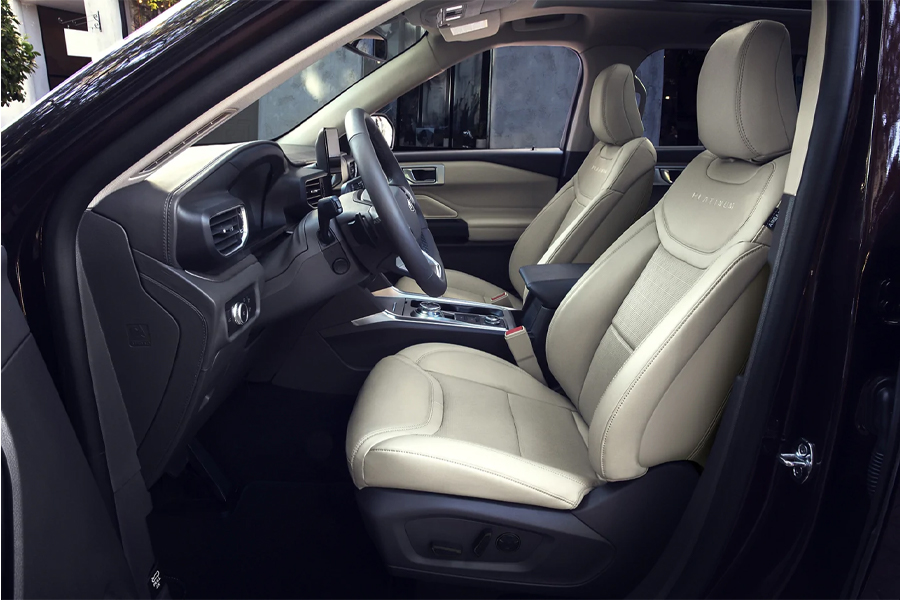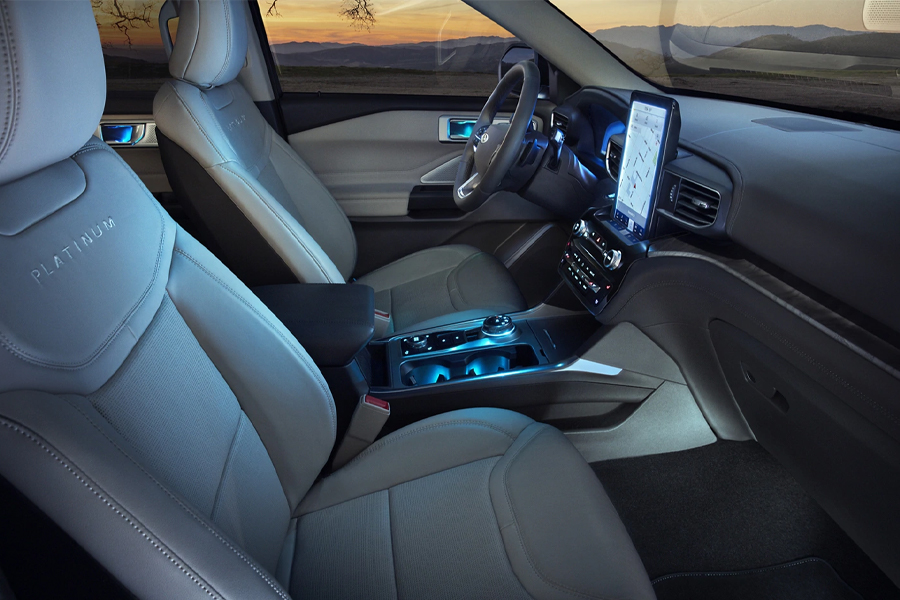The Ford Explorer returns with minor changes for 2021, after coming off of a full redesign in 2020. It delivers a smooth, comfortable ride with its powerful engine and three rows of seating. The 2021 Santa Fe receives a refresh this model year and has some changes of its own. Let’s see how the two compare.
Design
The 2021 Ford Explorer is a midsize three-row SUV with seating for seven or six, with optional second-row captain’s chairs. The front seats are spacious and comfortable, though there is less room in the rear seats. Cargo space gives you 18.2 cubic feet behind the third row, 47.9 cubic feet with the third row folded down, and up to 87.8 cubic feet with the second and third rows folded down. Cloth upholstery and power-adjustable front seats are standard and leather upholstery, heated and ventilated front seats, front sport seats, heated second-row seats, a heated steering wheel, power-folding third-row seats, and massaging front seats are available. A power liftgate comes standard; an available hands-free liftgate and a cargo management system that adds under-floor storage and a reversible cargo floor is an option. The Explorer is available in base, XLT, Limited, ST, and Platinum trim levels.

The 2021 Hyundai Santa Fe visual refresh includes a bolder front-end styling and improvements to its interior. It provides a generous amount of room for up to five passengers, seating comfortably in two rows. It also offers a fair amount of cargo space, with 35.9 cubic feet of cargo space behind the second row and 71.3 cubic feet with the back seat folded down. The Santa Fe offers plenty of quality in its interior, with nicer soft-touch materials, and a gear shift that adopts a push button layout. Options include reclining rear seats, heated rear seats, ventilated front seats, and leather upholstery. A new lighting signature includes T-shaped LED daytime running lights, and now there is a LED lighting strip connecting the taillights, along with a new skid plate and reflector. The Santa Fe also gains a fancy Calligraphy trim level with quilted leather upholstery, and unique exterior accents and more upscale interior embellishments. Trim levels include: SE, SEL, Limited, and Calligraphy.
Safety and Technology
The Ford Explorer has an impressive list of safety and tech features, including a highly rated SYNC 3 infotainment system with an 8-inch touch screen that quickly connects to your smartphone with Apple CarPlay and Android Auto. Six speakers, satellite radio, a Wi-Fi hot spot, and four USB ports are also standard. Available features include a 10.1-inch touch screen with a portrait layout, a 12.3-inch customizable driver display, a 14-speaker Bank & Olufsen sound system, a rear-seat entertainment system, and wireless device charging. For added assistance, the Explorer comes with Ford Co-Pilot360 technology and driver-assist features to add ease and safety to your driving. Standard safety features include blind spot monitoring, rearview camera, lane-keep assist, forward automatic emergency braking, pedestrian detection, and auto high-beam headlamps.

The Hyundai Santa Fe is outfitted with a user-friendly infotainment system that features an 8.0- or 10.3-inch touchscreen with Apple CarPlay and Android Auto. An optional wireless charging and a 630-watt, 12-speaker audio system is available. Standard safety features include forward-collision warning and automated emergency braking, adaptive cruise control with stop-and-go technology, lane-departure warning and lane-keep assist, and trailer sway damping. Blind-spot monitoring, rear-passenger safe exit system, and an automated parking system is added to higher trims.
Power
The Ford’s standard turbocharged 2.3-liter four-cylinder engine with 300 hp comes with a smooth and sturdy 10-speed automatic transmission and a rear-wheel-drive platform. There are two available twin-turbocharged V6s that will put out 365 and 400 horsepower and are also paired with a 10-speed automatic transmission. Four-wheel drive comes standard in the two highest trims, but you can add four-wheel drive to the other trims for added cost. The base engine is not short on power, but the V6 options are quicker. Estimated fuel economy is 21/28 mpg in the city and on the highway with its base engine and 18/26 mpg city/highway with the twin-turbo V6 engines. When properly equipped, the Explorer can tow up to 5,600. The base Explorer has a starting price of $33,000 and ranges to a starting price of $59,000 for the Platinum.

The Santa Fe is standard with a 2.5-liter four-cylinder engine paired with an eight-speed automatic transmission. The Limited and Calligraphy come with a turbocharged 2.5-liter four-cylinder paired with an eight-speed dual-clutch automatic transmission that puts out 277 horsepower. Both options are standard with front-wheel drive or optional all-wheel drive. It provides a stable and a relaxed ride during every day driving; but its base engine is not quick or powerful. Its turbocharged engine delivers more acceleration, but is still underpowered than the Explorer. The Santa Fe will earn up to 25/28 mpg city and highway. It can tow from 2,000 to 3,500 pounds depending on the engine the Santa Fe is equipped. Starting price for the SE is $28,035 and ranges to a starting price of $43,285 for the Calligraphy trim.
Conclusion
The 2021 Ford Explorer excels in its power and athletic abilities and offers more seating and cargo space with plenty of features. The 2021 Santa Fe comes with some quality features, less passenger room but with comfortable seating throughout its cabin, and a lower price tag. Compare the two and choose one to meet your lifestyle.